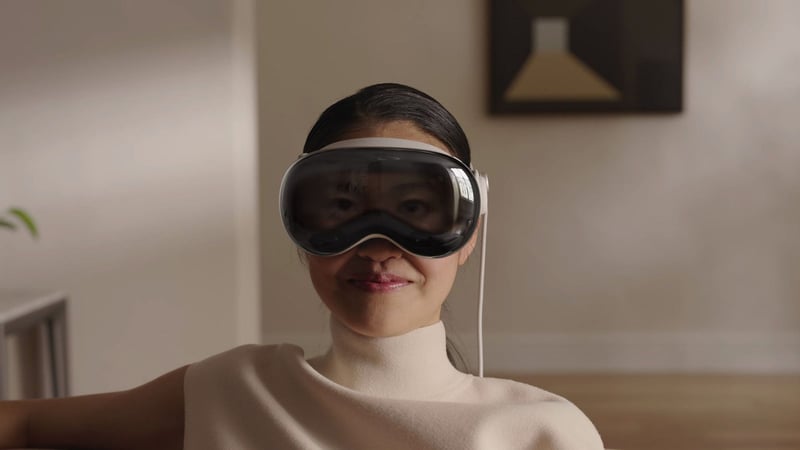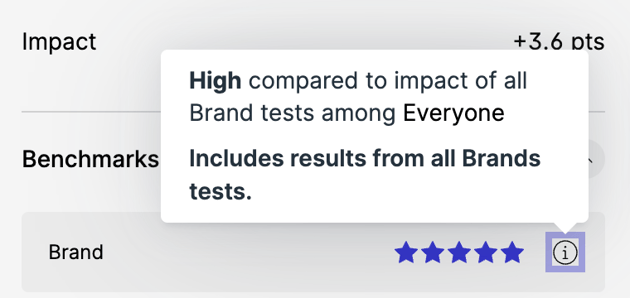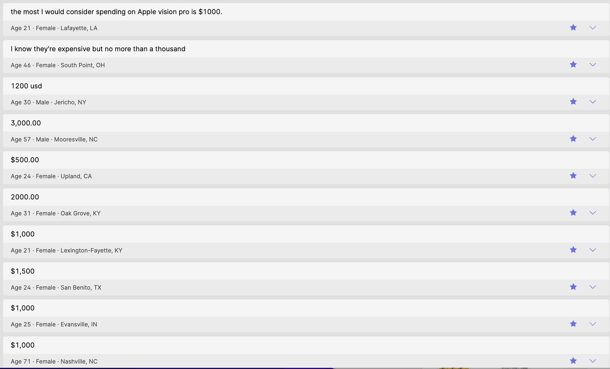What's the Demand for the Apple Vision Pro? We Ran a Study ⤵️
 By
Michelle Wiles
·
4 minute read
By
Michelle Wiles
·
4 minute read
People are intrigued by the Apple Vision Pro. The price? Not so much.
Yesterday, Apple released details about its long awaited headset: the Apple Vision Pro. Part virtual reality, part augmented reality, the headset promises a seamless connection between computing and humanity.

For us at Swayable, this release is a perfect opportunity to use our persuasion testing platform to answer: what is the interest in the new Apple device?
Setting up the study:
We assessed (3) metrics:
- Product Consideration: How would you describe your overall attitude towards Apple Vision Pro? How likely are you to recommend Apple Vision Pro to a friend or colleague?
- Purchase Intent: How likely are you to consider purchasing Apple Vision Pro? Do you plan to buy Apple Vision Pro in the next 6 months?
- Price: What is the maximum price you would pay for the Apple Vision pro?
Methodology: We took the Apple Vision Pro announcement clip and showed it to one audience. We showed an unrelated video to a separate audience. Then we assessed the difference in metrics between the two audiences.
What did people think of the Apple Vision Pro announcement?
1. People like the product.
The Apple Vision Pro announcement drove a statistically significant increase in consideration for the headset:

The +3.6 increase puts Apple’s Vision Pro announcement in the top quintile of brand communications:

2. But, people do not necessarily plan to *buy* the product

While Product Consideration went up, Purchase Intent actually went down after the announcement.
Why? One reason could be the newness of the product. People aren’t used to wearing a computer on their face. And after Google Glass’ notorious flop, customers might be skeptical about adopting this device, even if the launch video makes it look very cool.
However, the likely culprit is the price. At $3,499 (pre-tax), the Apple headset is out of range for most discretionary budgets. A video from a live screening of the announcement confirmed the not-so-positive sentiment about the price:
3. People are willing to spend ~$1,000 on the device
We used the qualitative question feature of Swayable to ask: What is the maximum you would spend on the Apple Vision Pro?
Results were mixed, with answers ranging from $300, all the way up to $4,000. But, the most common answer was $1,000.
This is a good thing for Apple.
Meta’s Quest 2 can be purchased for $299.99, which means Apple has significantly raised the value of a mixed reality headset, similar to how Apple convinced a generation to start spending $1,000+ on a new phone every two years.

Nevertheless, most answers fell short of the $3,499 price tag Apple has set. This, again, could be fine for Apple. In fact, it could be the objective. Apple surely knows most people cannot afford to drop nearly $4k on a single device. But, this is the first Apple product to launch with the ‘Pro’ name without an entry-level equivalent product since the MacBook Pro in 2006. Does that mean a non-pro version is on the way? 🤔
What does “pro” actually mean for Apple’s new headset? While the iMac Pro, Mac Pro, and MacBook Pro have all been targeted at high-level professionals in the past, the audience for the Apple Vision Pro is a lot less obvious. — The Verge
Perhaps the addition of the word ‘Pro’ offers Apple the ability to start at a high price, and then remove the Pro for a lower priced, more mass option.
It would be smart on Apple’s part; the Vision Pro is more than a new device, it’s a new platform that will require a new set of apps, and there are still questions around what people will actually regularly use it for. By pricing the product for early adopters (with full features), Apple gives the opportunity for developers and tech aficionados to test the new technology, which Apple can then whittle down to a more consumer-oriented version in the future non-Pro vision.
Differences among audience segments
The Apple Vision Pro announcement did not impact all audiences the same.
1. Age segments
Interestingly, the announcement swayed older segments (55+) more positively than younger ones (under 35).

2. Income segments
The video was also quite effective in growing consideration among lower income segments (<$40k).
It’s important to note the baseline scores are higher for higher income segments (which means higher income segments had higher demand for the Apple device without seeing the video announcement). However, after seeing the video (and the price!), higher income segments had a negative shift in purchase intent:

3. Tech early adopters
Finally, we created our own custom segment, ‘Tech Early Adopters’ made up of respondents who said they would consider themselves to be an early adopter.
‘Tech adopters’ had a higher baseline consideration (69.1 for tech adopters vs. 57.8 for non-adopters). However, they might have already been sold on the product, as the announcement only shifted their consideration slightly. Non-adopters (who may have been less unaware of the headset), showed a much larger increase in Product Consideration:

Predicting the Vision Pro’s success
Apple has a remarkable history of releasing game-changing products that reach mass adoption. The iPhone is the obvious case, but AirPods have essentially paved the way for wearable tech to become normal.
Will the Pro Vision follow the same path? Swayable’s data shows the price is a barrier. But interest is largely positive. And Apple has a habit of raising willingness to pay…
Want to test how a video shifts interest in own product? Book a Swayable demo.
